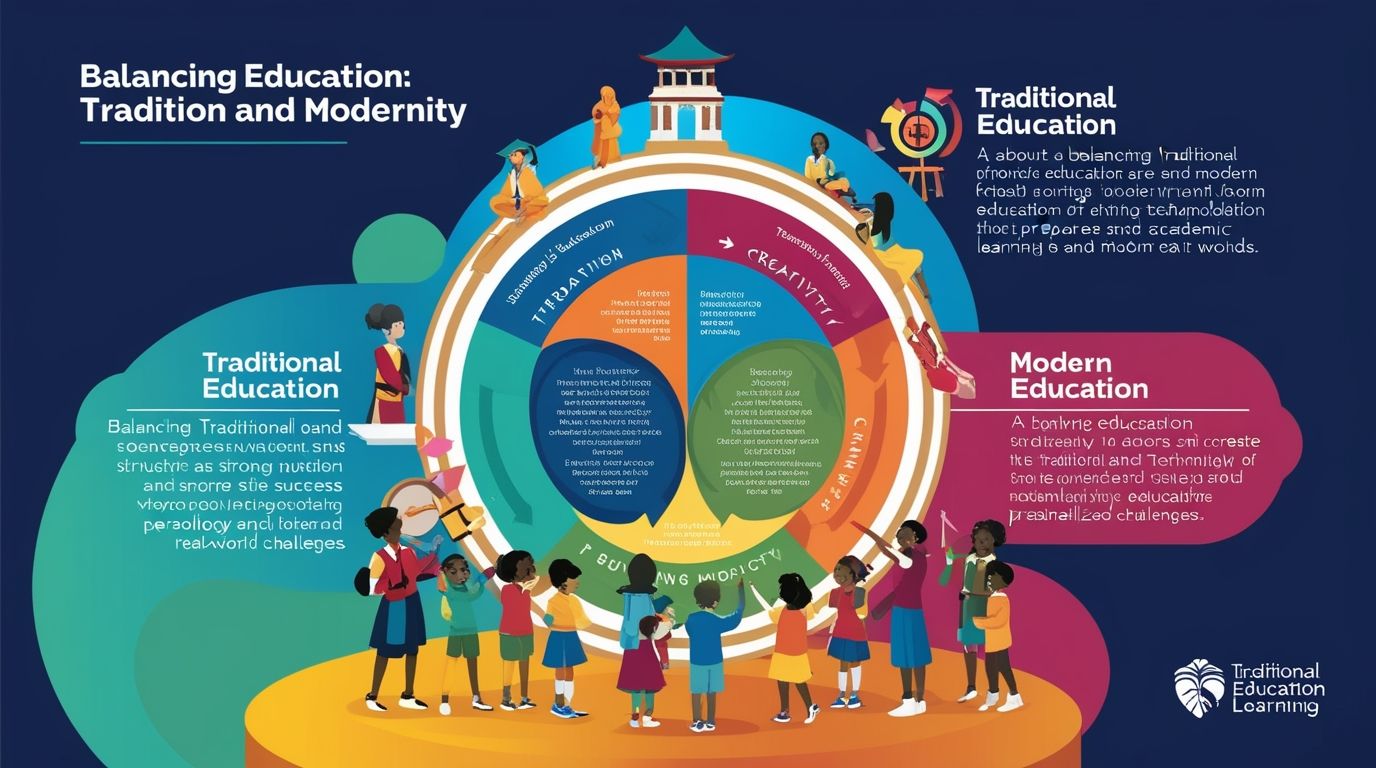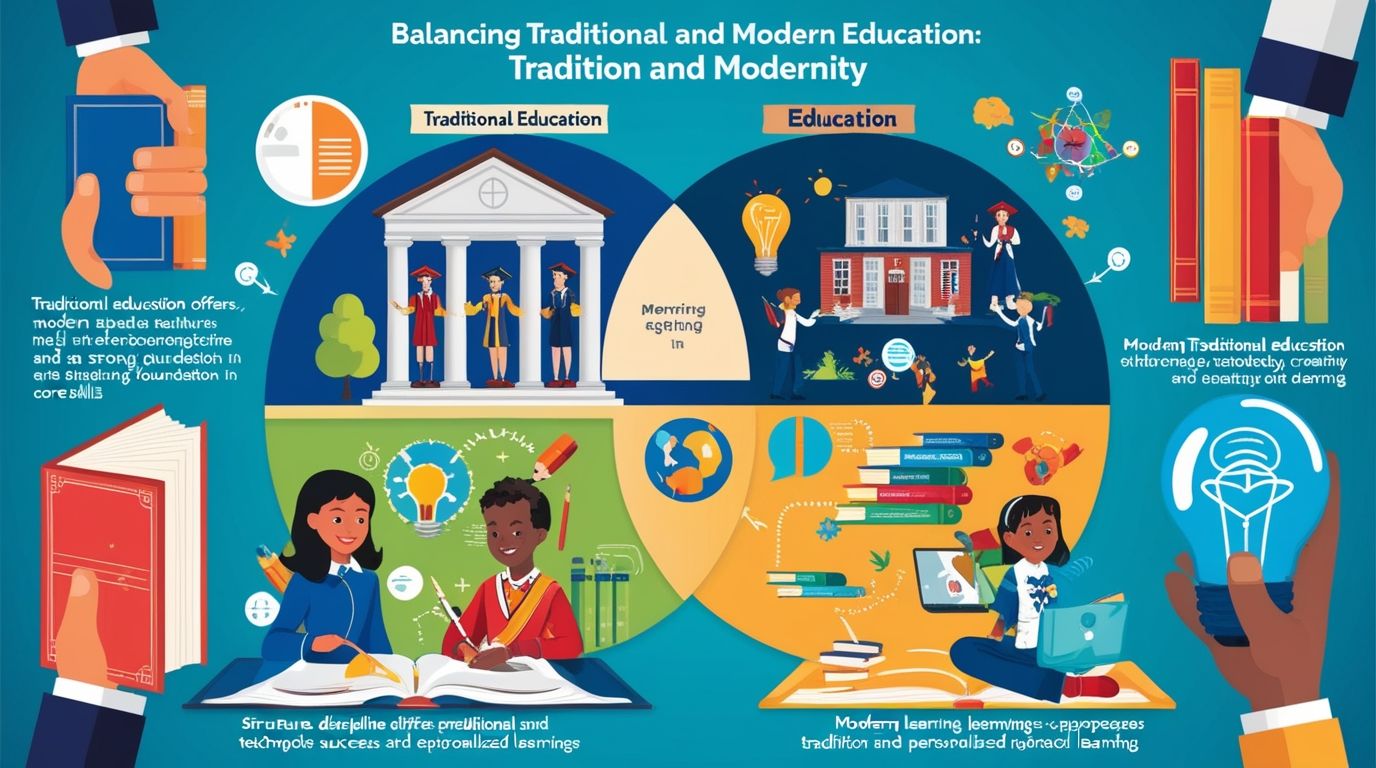Balancing Education: Weaving the Threads of Tradition and Modernity
Balancing Education Tradition and Modernity, Balancing traditional and modern education is about merging the best of both worlds. Traditional education offers structure, discipline, and a strong foundation in core skills, while modern education emphasizes technology, creativity, and personalized learning. By blending these approaches, educators can create a holistic learning environment that prepares students for both academic success and real-world challenges. The key is to integrate the stability of traditional methods with the innovation of modern techniques, fostering an adaptable and inclusive educational experience that meets the diverse needs of today’s learners. —a dance between the tried-and-true methods of traditional instruction and the innovative approaches of modern learning. The question looms: How can we balance the best of both worlds?
The Roots of Tradition: Stability in Learning
Traditional education, with its roots deep in history, offers a structured and familiar approach to learning. It is characterized by teacher-led instruction, a clear curriculum, and an emphasis on foundational skills. There’s something comforting about the predictability of traditional education—the neat rows of desks, the sound of chalk on blackboard, and the discipline it instills.
Consider the strengths of this approach: it prioritizes literacy, numeracy, and disciplined study habits. Students learn to respect authority and follow a structured routine, which can be crucial for developing self-discipline and focus. The traditional classroom, with its clear hierarchy and established rules, provides a stable environment that many students find conducive to learning (Hattie, 2009).
However, the challenges of traditional education cannot be overlooked. Its rigidity often stifles creativity, and the focus on rote memorization can leave little room for critical thinking or problem-solving. In an age where adaptability and innovation are key, this model sometimes feels like an old, creaky ship struggling to navigate the fast currents of the modern world (Dewey, 1938).
The Rise of Modern Education: Innovation in Action
Modern education has flipped the classroom—quite literally in some cases. The advent of technology has transformed learning into a more dynamic, interactive experience. Gone are the days when students were passive recipients of information. Now, they are active participants, exploring subjects through project-based learning, digital simulations, and collaborative activities.
Picture a modern classroom: students coding a robot, creating multimedia presentations, or discussing global issues with peers halfway across the world via video chat. This is the promise of modern education—learning that is personalized, relevant, and engaging (Prensky, 2001). It recognizes that students are not just vessels to be filled with information, but explorers with the world at their fingertips.
But with innovation comes its own set of challenges. The allure of screens and gadgets can lead to distractions, and not all students have equal access to the latest technology. Moreover, the shift towards student-centered learning can sometimes neglect the foundational skills that traditional education emphasizes (Fullan & Langworthy, 2014). There is a delicate balance to be struck between freedom and structure, between innovation and discipline.

The Art of Blending: Creating a Harmonious Learning Environment
So, how do we weave these contrasting threads into a cohesive fabric? The answer lies in blended learning—a hybrid approach that combines the strengths of traditional methods with modern innovations. Blended learning isn’t just a compromise; it’s a carefully crafted strategy that leverages the benefits of both worlds to create a richer educational experience.
Imagine a high school history class where the teacher uses traditional lectures to introduce the key concepts of World War II, followed by a modern twist: students dive deeper through interactive online maps, virtual reality experiences of historical sites, and group discussions conducted via a learning management system. This blend ensures that students receive a strong foundational understanding while also engaging with the material in a way that feels relevant and exciting (Bonk & Graham, 2006).
Blended learning allows for flexibility. It can accommodate different learning styles and paces, making education more inclusive. A student who struggles with traditional lectures might excel when given the opportunity to learn through hands-on activities or digital simulations. Conversely, those who thrive on structure can benefit from the clear guidance that traditional methods provide (Reigeluth & Beatty, 2004).
Implementing a Balanced Approach: Strategies and Challenges
Balancing traditional and modern education requires thoughtful planning and execution. It’s not as simple as sprinkling a few digital tools into a traditional classroom. It involves rethinking the curriculum, investing in teacher training, and ensuring that all students have access to the resources they need.
Curriculum Design: A balanced curriculum should integrate technology in a way that enhances learning, not just for the sake of using gadgets. For example, using data analytics to track student progress can help tailor instruction to meet individual needs while maintaining the integrity of traditional teaching methods (Christensen, Horn, & Johnson, 2008).
Teacher Training: Educators are at the heart of this transformation. Providing teachers with professional development opportunities to learn new technologies and pedagogical strategies is crucial. It’s not enough for teachers to know how to use the tools; they must understand how to blend them with traditional methods to maximize student learning (Hattie, 2009).
Assessment Methods: Balancing traditional and modern education also means rethinking assessment. Standardized tests have their place, but incorporating project-based assessments, digital portfolios, and peer evaluations can provide a more holistic view of student learning. This approach not only measures what students know but also how they apply their knowledge in real-world contexts (Vygotsky, 1978).
Classroom Management: Finally, managing a blended classroom requires a flexible mindset. Teachers must be adept at shifting between structured and open-ended activities, balancing discipline with student autonomy. It’s about creating an environment where structure and creativity coexist, where rules guide but do not confine (Bonk & Graham, 2006).
Overcoming Challenges: A Path Forward
Balancing traditional and modern education is not without its hurdles. Resistance to change is common, both from educators who are set in their ways and from institutions hesitant to invest in new technologies. There’s also the issue of equity—ensuring that all students, regardless of their background, have access to the benefits of modern learning tools (Fullan & Langworthy, 2014).
However, the path forward is clear. It requires a commitment to continuous evaluation and adaptation. Schools must be willing to experiment, learn from their experiences, and make adjustments as needed. It’s about embracing the mindset that education, like the world around us, is constantly evolving.
Conclusion: The Future of Education
The future of education lies not in choosing between traditional and modern approaches but in finding the right balance. By blending the stability and discipline of traditional methods with the engagement and innovation of modern techniques, we can create a learning environment that is both effective and inspiring.
In this harmonious blend, students are not just learning to pass exams; they are learning to think critically, solve problems, and navigate an ever-changing world. They are prepared not just for the classroom, but for life. And that, after all, is the true goal of education.
References
- Prensky, M. (2001). Digital Natives, Digital Immigrants. On the Horizon.
- Fullan, M., & Langworthy, M. (2014). A Rich Seam: How New Pedagogies Find Deep Learning. Pearson.
- Dewey, J. (1938). Experience and Education. Collier Books.
- Christensen, C. M., Horn, M. B., & Johnson, C. W. (2008). Disrupting Class: How Disruptive Innovation Will Change the Way the World Learns. McGraw-Hill.
- Vygotsky, L. S. (1978). Mind in Society: The Development of Higher Psychological Processes. Harvard University Press.
- Reigeluth, C. M., & Beatty, B. J. (2004). Instructional-Design Theories and Models: A New Paradigm of Instructional Theory. Lawrence Erlbaum Associates.
- Bonk, C. J., & Graham, C. R. (2006). The Handbook of Blended Learning: Global Perspectives, Local Designs. Pfeiffer.
- Hattie, J. (2009). Visible Learning: A Synthesis of Over 800 Meta-Analyses Relating to Achievement. Routledge.

8 thoughts on “Balancing Education Tradition and Modernity”
Comments are closed.